AMD's Zacate APU Performance Update
by Anand Lal Shimpi on September 15, 2010 5:04 AM EST- Posted in
- CPUs
- AMD
- Zacate
- Trade Shows
It’s 12:43AM and I just got back into my hotel room. I spent the past few hours in AMD’s suite a block from IDF trying to get to the bottom of an issue we discovered in our post on AMD’s Zacate GPU performance numbers earlier this week.
Let’s recap. Zacate is AMD’s 18W APU aimed at the mainstream notebook market (~$500 notebooks). The APU features a pair of Bobcat cores and a Cedar-class AMD DX11 GPU. Spending some time with the physical Zacate package, it seems to have a single 64-bit DDR3 memory interface ala Atom. Unlike Atom however, both the Bobcat cores and the DX11 GPU should be relatively high performance.
Earlier this week, AMD showed us the first public demonstration of Zacate. In its suite were two systems: a Zacate test platform and a Core i5-M 520 notebook from a major OEM. Both systems were configured with 4GB of memory and were running the 64-bit version of Windows 7 Premium.

AMD's Zacate
The first demo we saw on Monday was the system running City of Heroes. In CoH Zacate managed to reach frame rates around 2x of what we saw on the Core i5-M 520. AMD also ran through a number of IE9 performance tests including the Psychadelic HTML5 benchmark and the Amazon Shelf test. In both of those tests, the Zacate platform was significantly faster than the Core i5-M 520. And it was those IE9 tests that seemed suspect.
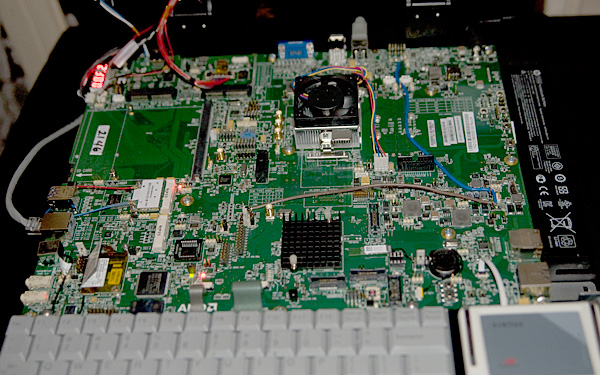
The Zacate test platform
I didn’t think much of it at first, but Zacate managed a ~10x performance advantage in the IE9 Psychadelic benchmark. While Zacate should have a higher performance GPU, it shouldn’t be that much faster. Something was amiss.
I borrowed a Core i5 notebook from Intel (we are at IDF after all) and ran the same tests on it. The performance was much better than what I saw in AMD’s suite. I went back to AMD to find out exactly what was going on.
I brought up the issue and AMD immediately began looking into it. AMD used the latest drivers made available for this particular Core i5 notebook on the manufacturer’s website. Those drivers were version 2104 dated 3/31/10. AMD explained that these systems were configured about a month before launch and they were using the latest drivers available on the manufacturer’s website at the time. This particular OEM didn’t offer a newer version of the Intel HD Graphics drivers via its website. To make matters worse, Intel’s updated HD Graphics driver wouldn't install on the notebook. Some notebook OEMs prefer to provide their own display driver updates. In those cases, the Intel HD Graphics drivers available from intel.com won’t install. Despite only having a single Core i5 machine for all of its press demos for tomorrow, AMD agreed to let us manually install the driver (extract the driver and force device manager to update the driver manually) on the i5 system.
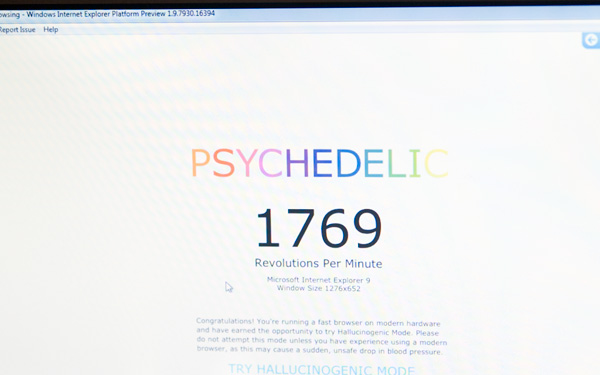
Zacate
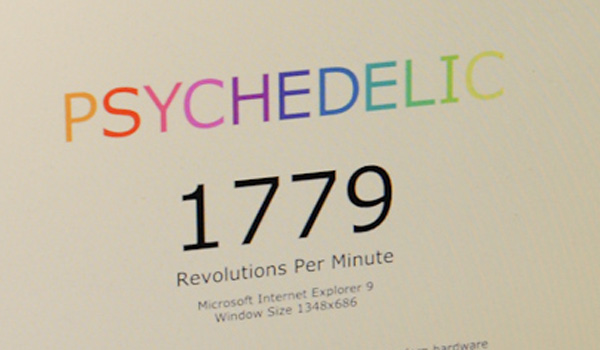
Intel Core i5-M 520 w/ latest drivers
The updated driver brought the IE9 performance tests to parity with Zacate. In fact, it looks like the IE9 benchmark doesn’t scale too far with GPU performance (apparently discrete cards don’t score much higher than what we’ve seen here).
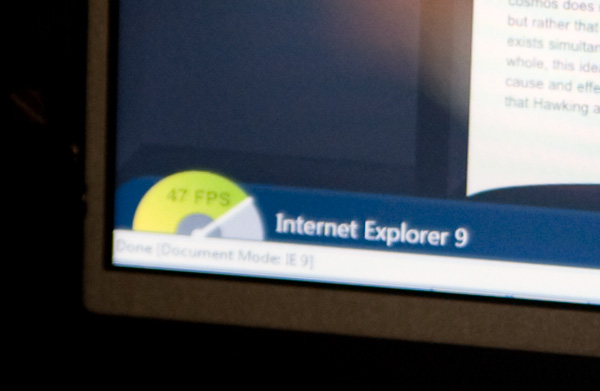
Zacate
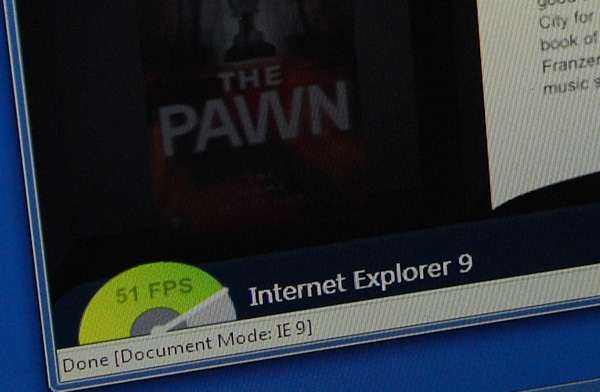
Intel Core i5-M 520 w/ latest drivers
At this point we had an issue. The IE9 benchmarks AMD was showing off weren’t an accurate comparison of the two architectures. While valid for the only driver revision supported on this particular Core i5 notebook, the scores weren’t valid for a Zacate vs. Core i5 architecture comparison. AMD wanted to make sure there was no confusion about the GPU performance potential of Zacate so it allowed us to install whatever we wanted on both systems to validate the GPU performance we had seen.
Take a moment to realize exactly what just happened here. In an effort to convince us (and you) that it had nothing to hide and didn’t deliberately attempt to stack the deck, AMD gave us full access to the Zacate platform to do whatever we wanted. AMD wanted us to be completely comfortable with the Zacate comparison.
We downloaded the Batman Arkham Asylum demo off of Steam and loaded it on both the Zacate and Core i5 systems (AMD originally bought two copies of the full game via Steam only to find that SecureROM kept crashing on the Zacate platform at launch, way to go SecureROM). We set both machines to 1024 x 768 at high quality settings. We played through the beginning of the demo as well as FRAPSed a short walk through the first room you’re dropped in:
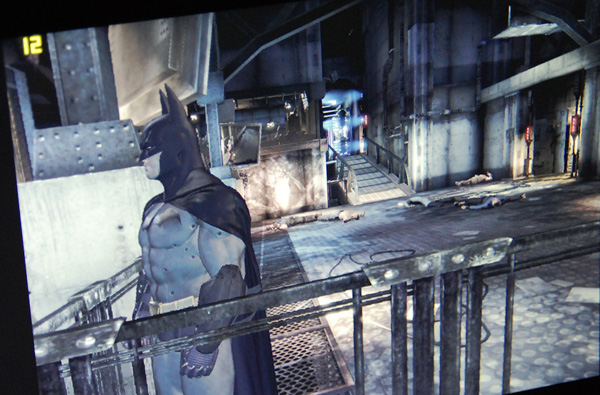
Batman, Core i5-M 520
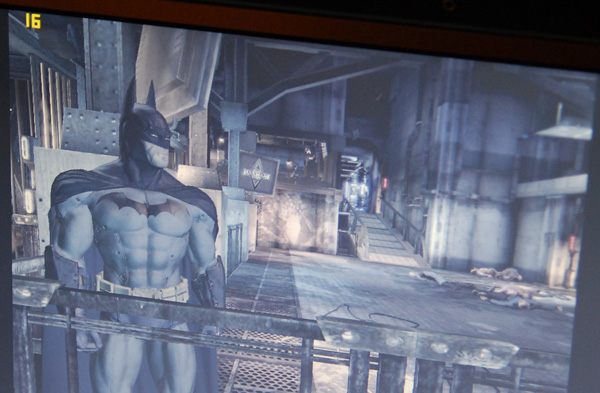
Batman, Zacate
| Batman Arkham Asylum, FRAPS Walkthrough, 1024 x 768 High Quality | ||||
| AMD Zacate | Intel Core i5-520M | |||
| Batman | 16.5 fps | 11.3 fps | ||
The actual gameplay was noticeably quicker on Zacate and the numbers show a 45% performance advantage. This is huge. To sanity check that data we fired up City of Heroes on both machines and played around with them. The frame rate varied depending on where you were in the scene and we saw peak frame rates close to the 2x advantage repeated in our second pass with updated Intel drivers. Note the differences in contrast below are due to the vastly different screens the two systems were using.
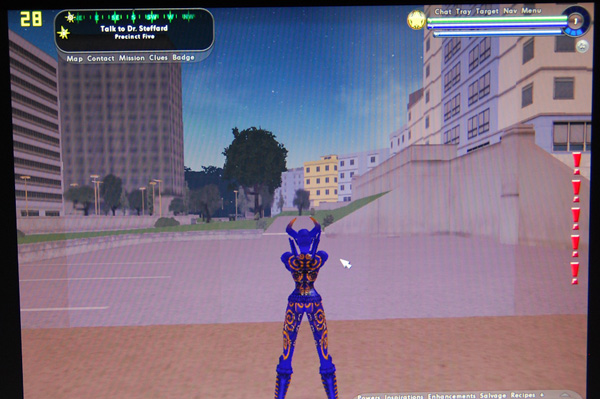
City of Heroes, Core i5-M 520

City of Heroes, Zacate
We put together a quick FRAPS walkthrough to show how the average frame rate improved:
| City of Heroes, FRAPS Walkthrough, 1024 x 768 Low Quality | ||||
| AMD Zacate | Intel Core i5-520M | |||
| City of Heroes | 39.6 fps | 25.5 fps | ||
On average we saw a 55% improvement over the Core i5 system.
AMD wanted to highlight the DirectCompute performance of Zacate and let us publish the first results from the platform running the N-Body Simulation benchmark:
| N-Body Simulation, DirectCompute Performance | ||||
| AMD Zacate | Intel Core i5-520M | |||
| N-Body Simulation | 23 GFLOPS | 8.8 GFLOPS | ||

AMD views Fusion as a way to not only bring better gaming performance to the market, but also enable a lot of new GPU compute applications. Remember that Zacate and Ontario are going into systems priced at around $500 or less. With this type of GPU compute in the entry level, it’s only a matter of time before developers start to do something with it.
The Zacate GPU performance we’re seeing here today is completely unoptimized as well. The clocks aren’t final, drivers aren’t fine tuned and although we’re close to release, there’s still potentially more performance on the table.
It’s very rare for any public company to make an on the spot decision to let us benchmark and publish test data of an unreleased part without having ever seen it before. The first time the AMDers in the suite saw Zacate running Batman was when we installed it. To be honest, it was probably the most open and flexible I’ve ever seen AMD be. I knew if the IE9 numbers changed that it would call the City of Heroes numbers into question. By allowing us to rerun everything as well as add an additional title (one that we’ve used more recently) AMD handled the situation perfectly.
At the end of the day my take on Zacate (and Ontario) hasn’t changed: these two APUs have the potential to make the low end netbook/notebook market interesting again.










96 Comments
View All Comments
Lonyo - Wednesday, September 15, 2010 - link
Hence the "as well".It's not an accurate performance comparison, but it is potentially an accurate state of play comparison.
AMD has both the superior product, and also (potentially) superior support for that product, as shown by the first test when it went horribly wrong for Intel because their drivers aren't well done (and by that I don't mean bad coding, but an overall bad system of drivers).
Best case scenario: Intel performs on par in this seemingly poorly scaleing test.
Worst case: Intel gets about 10% of the score because of poor support.
spart - Wednesday, September 15, 2010 - link
hedge is ridiculous to compare the next generation of AMD withand intel generation that is leaving behind, should be zacate or ontario vs sandy
bridge
duploxxx - Wednesday, September 15, 2010 - link
AMD Zacate launch date is Q4 2010, priliminary SB launch date is indeed just first or second week of 2011 however not the CULV parts, that will take 2more quarters according to official roadmap, so yes this test is valid.http://www.anandtech.com/show/3876/intels-core-201...
stalker27 - Wednesday, September 15, 2010 - link
Do you call Fermi vs Evergreen a "ridiculous" comparison?Shadowmaster625 - Wednesday, September 15, 2010 - link
Yeah but intel's next generation will not be had for $500. There is nothing on the netbook roadmap for intel except a new crappy atom.justjc - Wednesday, September 15, 2010 - link
This article is based on a test made on a available prototype Zacate APU notebook which AMD compared to a Intel solution they could get their hands on. (Even Anandtech haven't gotten to play with a Sandy bridge Notebook)Besides Sandy Bridges direct competition, at a similar price point, will be the mobile variant of AMDs Llano and not their Ontario or Zacate APUs.
The market the Zacate APU will compete in is low to midrange notebooks, where the Core i5 520M notebook solution is a reasonable representative as a 2011 midrange(around $500 notebook) part. After all that is where the current last generation, the Core2Duo solutions, still exist today.
crazzeto - Wednesday, September 15, 2010 - link
I very much agree with this... In particular because I tried a "force install" of standard nvidia drivers on my HP laptop and it caused some very serious and bizzar issues. A less experienced user would never have figured out the issue, and frankly HP was completely useless when I originally contacted them (they claimed I installed bad memory).So in many cases, the OEM drivers are the way to go anyhow.
fic2 - Wednesday, September 15, 2010 - link
I tried updating a friends HP laptop with new video drivers but the "newest" that HP has are 2 years old. This laptop has an nvidia card so I know that there are newer drivers but since it isn't my laptop I just installed the 2 year old set. Pretty crappy that you have to install HP "official" drivers. Turned me off of HP laptops until you can use standard Nvidia/AMD/Intel graphic drivers.larson0699 - Wednesday, September 15, 2010 - link
In my experience, the official drivers can always be installed via Device Manager (in fact, that was the original way to install drivers, anyway), but as you mentioned about the odd issues, I've seen my share of those as well, no problems with acceleration or artifacting, but mostly the BSoD from nv4_disp.dll. It's just a sad testament to the nonstandard implementations of mobile GPUs, especially the nonremovable ones. That's why I really didn't care about picking up a secondhand machine with GMA 900 -- when I didn't expect much out of it anyway, there's little disappointment to be had. Naysayers can extrapolate that statement all they want, but when I need GPU muscle, I stick with the tried and true (built desktops) where at least I'm expected to download the latest driver. Uniformity would be nice -- I don't think it's as hard to support ANY mobile platform with your name on it in Windows as it is to port your drivers to another OS.Disregard all that. Stupid end user talking.
ellarpc - Wednesday, September 15, 2010 - link
I just ran the Psychedelic test on two completely different systems and got almost identical scores to that of the i5-M and the Zacate. first system I ran it on was a 65nm core 2 duo E6750 @ 2.66GHz with a 9800GX2, Psychedelic score1789... Next I grabbed an even older system a 90nm AMD Athlon 64 X2 3800+ @ 2.0GHz with a very old 6800GT, Psychedelic test score 1784. As far as raw GPU power the 9800GX2 is multiple times more powerful than a 6800GT and if the test was objective at all the core 2 and GX2 should have given very different numbers than the old x2 with a 6800gt...I wouldn't trust Microsoft's scoring they mainly want their test to be compared to other browsers.
Great Job Anand for putting AMD on the spot to test their product. I'm really hoping for good things for AMD next year. I look forward to your articles in the upcoming months. It's going to be exciting!